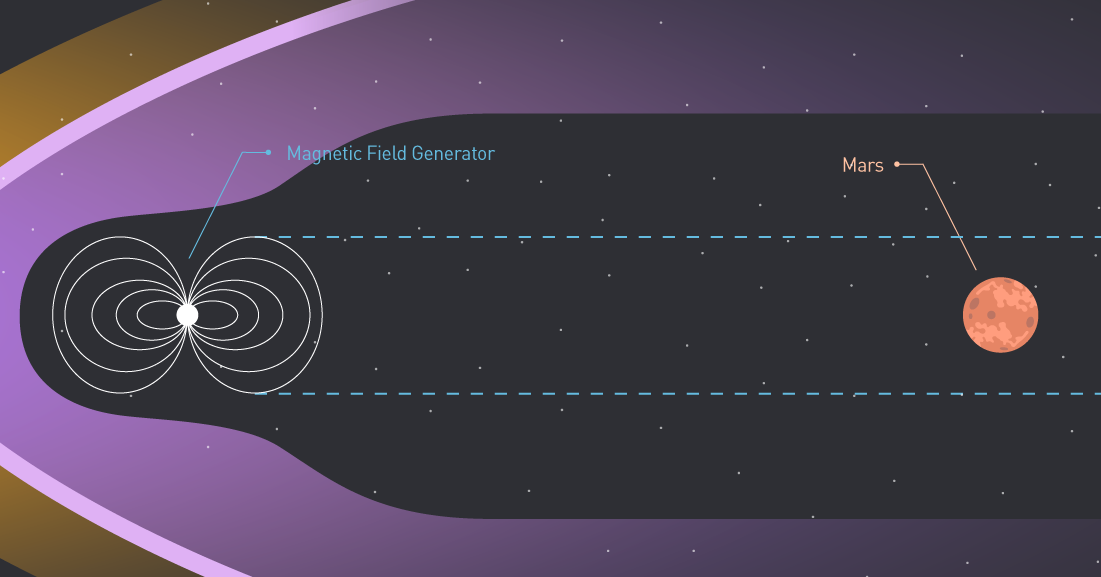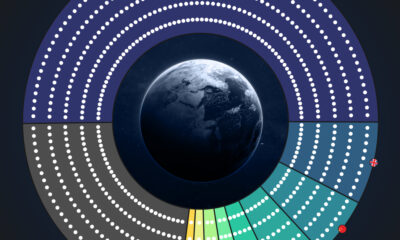Misc
Terraforming 101: How to Make Mars a Habitable Planet

Terraforming 101: How to Make Mars a Habitable Planet
Before we can journey to the stars, we must first go to Mars.
That’s Elon Musk’s philosophy, anyways – and just days ago he revealed new details on his ambitions to colonize the Red Planet, including sending two cargo rockets by 2022 and four rockets (two manned, two cargo) by 2024.
In 40 to 100 years, Musk suggested that up to a million people could live there.
Change of Seasons
As Elton John wisely noted, “Mars ain’t the kind of place to raise your kids”.
Indeed, the average temperature on Mars is −55 °C (−67 °F), dust storms are frequent and potentially deadly, and the planet has extremely low atmospheric pressure (about 1% of Earth). Because of the atmosphere and temperature swings, meaningful occurrences of liquid water on the planet’s surface are almost impossible. And while Mars is thought to have plenty of frozen water at its poles and in underground deposits, the logistics of tapping into these resources could be quite difficult.
In other words, for any meaningful and long-lasting human presence on Mars, we would likely want to alter the planet and its atmosphere to make it more habitable for human life. And while the exact mechanisms we would use to accomplish this are still up for debate, the basics behind what’s needed to achieve Earth-like conditions are actually pretty straightforward.
Terraforming 101
Today’s infographic comes to us from Futurism, and it details what might need to happen on Mars to make it more accommodating to human life.
Here are two steps we could take to get Mars into the “Goldilocks Zone”, where water is liquid – and harmful ionizing radiation like x-rays, UV rays, and gamma rays are not problematic.
Greenhouse Gases
One way to ward off harmful ionizing radiation is to add a thicker layer of greenhouse gases to the atmosphere of Mars. Such an atmosphere would also allows less heat to escape, meaning warmer temperatures on the planet.
Magnetic Field
A strong magnetic field on Earth is something else that makes life easier. Earth’s solid inner core, composed primarily of iron, creates this field when the planet spins – and it deflects cosmic rays and other harmful types of radiation.
One interesting solution to solve this problem on Mars would to have a magnetic field generator in front of the planet at all times, deflecting any such rays coming from the sun.
The Realm of Possibility
While terraforming is still a mixture of theory and science fiction at this point, we do know some of the major problems that have to be solved for attaining a habitable environment – and it will be interesting to see how plans around Mars develop as the prospect of colonization becomes more real.
You need to live in a dome initially but over time you could terraform Mars to look like Earth and eventually walk around outside without anything on. … So it’s a fixer-upper of a planet.
– Elon Musk
VC+
VC+: Get Our Key Takeaways From the IMF’s World Economic Outlook
A sneak preview of the exclusive VC+ Special Dispatch—your shortcut to understanding IMF’s World Economic Outlook report.

Have you read IMF’s latest World Economic Outlook yet? At a daunting 202 pages, we don’t blame you if it’s still on your to-do list.
But don’t worry, you don’t need to read the whole April release, because we’ve already done the hard work for you.
To save you time and effort, the Visual Capitalist team has compiled a visual analysis of everything you need to know from the report—and our upcoming VC+ Special Dispatch will be available exclusively to VC+ members on Thursday, April 25th.
If you’re not already subscribed to VC+, make sure you sign up now to receive the full analysis of the IMF report, and more (we release similar deep dives every week).
For now, here’s what VC+ members can expect to receive.
Your Shortcut to Understanding IMF’s World Economic Outlook
With long and short-term growth prospects declining for many countries around the world, this Special Dispatch offers a visual analysis of the key figures and takeaways from the IMF’s report including:
- The global decline in economic growth forecasts
- Real GDP growth and inflation forecasts for major nations in 2024
- When interest rate cuts will happen and interest rate forecasts
- How debt-to-GDP ratios have changed since 2000
- And much more!
Get the Full Breakdown in the Next VC+ Special Dispatch
VC+ members will receive the full Special Dispatch on Thursday, April 25th.
Make sure you join VC+ now to receive exclusive charts and the full analysis of key takeaways from IMF’s World Economic Outlook.
Don’t miss out. Become a VC+ member today.
What You Get When You Become a VC+ Member
VC+ is Visual Capitalist’s premium subscription. As a member, you’ll get the following:
- Special Dispatches: Deep dive visual briefings on crucial reports and global trends
- Markets This Month: A snappy summary of the state of the markets and what to look out for
- The Trendline: Weekly curation of the best visualizations from across the globe
- Global Forecast Series: Our flagship annual report that covers everything you need to know related to the economy, markets, geopolitics, and the latest tech trends
- VC+ Archive: Hundreds of previously released VC+ briefings and reports that you’ve been missing out on, all in one dedicated hub
You can get all of the above, and more, by joining VC+ today.
-

 Green1 week ago
Green1 week agoRanked: The Countries With the Most Air Pollution in 2023
-

 Automotive2 weeks ago
Automotive2 weeks agoAlmost Every EV Stock is Down After Q1 2024
-

 AI2 weeks ago
AI2 weeks agoThe Stock Performance of U.S. Chipmakers So Far in 2024
-

 Markets2 weeks ago
Markets2 weeks agoCharted: Big Four Market Share by S&P 500 Audits
-

 Real Estate2 weeks ago
Real Estate2 weeks agoRanked: The Most Valuable Housing Markets in America
-

 Money2 weeks ago
Money2 weeks agoWhich States Have the Highest Minimum Wage in America?
-

 AI2 weeks ago
AI2 weeks agoRanked: Semiconductor Companies by Industry Revenue Share
-

 Travel2 weeks ago
Travel2 weeks agoRanked: The World’s Top Flight Routes, by Revenue















